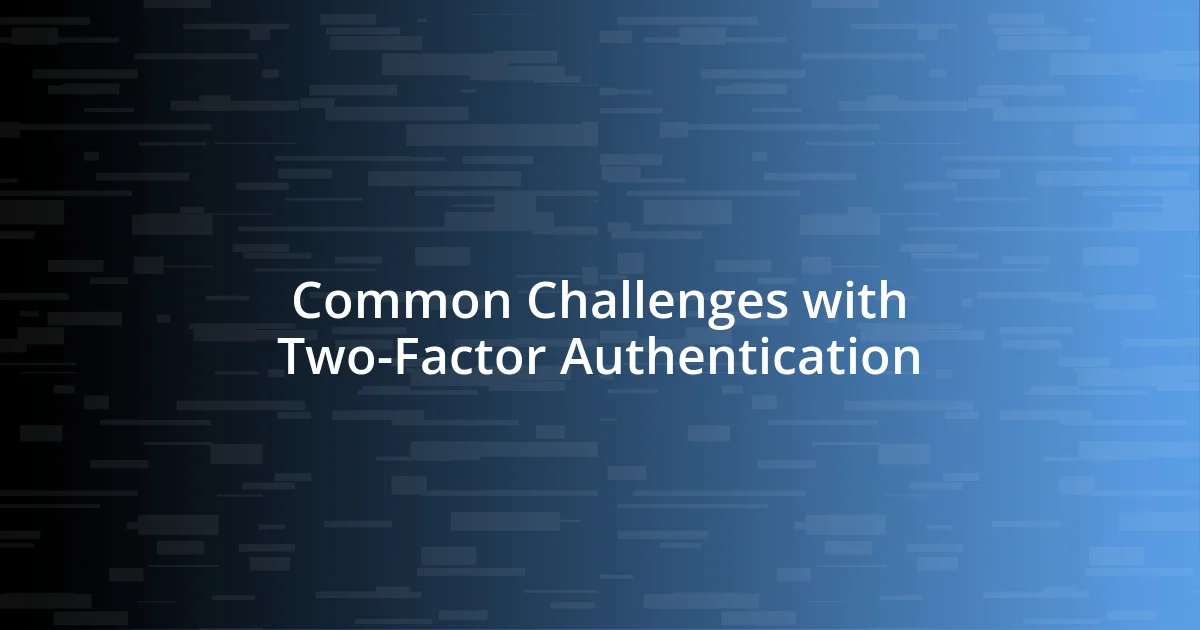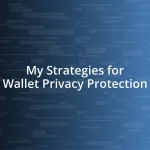Key takeaways:
- Two-Factor Authentication (2FA) enhances online security by requiring a second verification step, significantly reducing the risk of unauthorized access.
- Common challenges include issues with receiving verification codes and fears of being locked out of accounts; however, maintaining backup codes can mitigate these concerns.
- Regularly reviewing and updating 2FA settings empowers users to adapt to evolving security threats, reinforcing their online safety commitment.

Understanding Two-Factor Authentication
Two-Factor Authentication (2FA) adds an essential layer of security that goes beyond just a password. I still remember the first time I enabled 2FA on my accounts; it felt like putting a sturdy lock on my digital front door. Have you ever considered how many times a simple password could be compromised?
With 2FA, after entering my password, I receive a code on my phone that I need to enter to gain access. This extra step felt a bit tedious at first, but I quickly realized it was worth the peace of mind. I often pondered: what if someone had access to my accounts without this safeguard?
The beauty of 2FA lies in its simplicity and effectiveness. I’ve even had friends share their own experiences where 2FA saved them from potential hacks. It’s fascinating how a mere text message can drastically reduce the risks, isn’t it?

Reasons to Use Two-Factor Authentication
Using Two-Factor Authentication (2FA) significantly reduces the risk of unauthorized access to my accounts. I once received an alert that someone tried to log into my email from a different location. Thankfully, 2FA kicked in, and since I had to confirm the login attempt on my phone, I quickly denied access. It made me appreciate how this layer of security can act as a barrier against real threats.
Another reason I swear by 2FA is that it empowers me to take control of my online security. I remember a colleague who suffered a phishing attack, losing sensitive information. After that incident, I encouraged them to enable 2FA on all their accounts. The sense of control and security it brings is undeniably comforting. In a world where our personal information is constantly at risk, it feels good to know I’m taking proactive steps to protect myself.
I also find that implementing 2FA fosters a habit of vigilance. Each time I log in and must verify my identity, it reminds me to stay alert about my account’s security. When I shared these experiences with friends, they were surprised by how one small change can lead to such a significant impact on online safety. Implementing 2FA is truly one of the best decisions I’ve made for my digital life.
| Reason | Description |
|---|---|
| Enhanced Security | 2FA adds a second layer, making unauthorized access much harder. |
| User Empowerment | Gives users more control over their account safety and encourages proactive measures. |
| Increased Vigilance | Prompts users to be more aware of their account’s security status with every login. |

Setting Up Two-Factor Authentication
Setting up Two-Factor Authentication is a straightforward process, but it requires a little time and attention to detail. I recall the day I decided to take the plunge; I was pleasantly surprised by how quickly I could secure my accounts. Typically, you just need to go into your account settings and look for the 2FA option. Once I enabled it, I chose to receive codes via a text message, which felt like a perfect balance of security and convenience.
Here’s a quick guide to help you set it up:
- Navigate to your account security settings.
- Look for Two-Factor Authentication or 2-Step Verification.
- Choose your preferred method of receiving codes (text message, authenticator app, etc.).
- Follow the prompts to link your phone or app.
- Once set up, verify by entering the code sent to your phone or app.
I remember feeling a wave of relief wash over me after completing the setup. Knowing that my accounts were better protected made me more at ease in my online activities.

Common Challenges with Two-Factor Authentication
One common challenge I’ve faced with Two-Factor Authentication is the occasional hiccup in receiving verification codes. There have been times when my phone didn’t get the text messages promptly, leaving me feeling a bit anxious while trying to log in. I couldn’t help but wonder: what happens if I’m in a hurry and can’t access my account? It’s a frustrating scenario that makes me realize the dependence we have on technology for our security.
Another hurdle I’ve encountered is the different methods of 2FA, which can sometimes lead to confusion. I’ve tried both SMS and authenticator apps, but I definitely prefer the latter. Yet, I’ll admit that the initial setup felt a bit daunting. If you’ve ever questioned whether you’ve set it up correctly or if it’s even worth the trouble, I can relate. That uncertainty can be a real barrier to embracing the full benefits of 2FA.
Lastly, the fear of being locked out of accounts if I lose my device is something that weighs on my mind. I vividly remember the time I misplaced my phone for a few hours and was locked out of a few vital accounts. It sent a wave of panic through me—how would I regain access? This experience made me more appreciative of backup codes, which I now always store securely. It feels reassuring to have a plan in place, even as I navigate the complexities of two-factor authentication.

Tips for Effective Two-Factor Authentication
One of the best tips I can offer for effective Two-Factor Authentication is to always keep backup codes in a secure location. I once went through a panic when I realized my phone was dead, and I had no way to get the verification codes. It was a stark reminder for me of how crucial those backup codes can be. I recommend writing them down in a safe place, or even storing them in a password manager.
Additionally, choosing the right method for receiving your codes is essential. I’ve switched from SMS to using an authenticator app after a few frustrating incidents with delayed texts. It made me wonder—how much more secure am I when using an app? The difference is significant. The codes generated by authenticator apps are often more immediate and aren’t reliant on cellular service, which gives me peace of mind.
Lastly, remember to regularly review and update your authentication settings. I’ve made it a routine to check my 2FA configurations every few months. Each time I do, I reflect on how my security needs might have changed or evolved. Have there been new security threats that I might be exposed to? By staying proactive, I’m reinforcing my accounts against potential breaches, and it empowers me to embrace the digital world a bit more confidently.

Conclusion on Two-Factor Authentication
Reflecting on my experience with two-factor authentication, it’s clear that the added security it provides is invaluable. I remember a time when a friend’s account was hacked, leading to the loss of sensitive information. That incident genuinely shook me, making me appreciate how 2FA acts as a strong barrier. After witnessing that, I committed to using two-factor authentication on all my accounts. Sure, it takes a little extra effort, but the peace of mind it brings is absolutely worth it.
Yet, I can’t help but wonder if two-factor authentication is ever going to become a standard practice for everyone. As I talk to friends and family, I often hear them dismiss its importance, claiming it’s too complicated. I get it—the initial setup can be confusing, and I’ve felt overwhelmed myself. But once I overcame those early hurdles, I found that the sense of security far outweighed the initial frustration. Doesn’t that make it a worthwhile investment in our digital safety?
In the end, two-factor authentication is about more than just preventing unauthorized access; it’s a commitment to safeguarding our personal data. It’s made me more proactive about my online security; no longer can I afford to be complacent. I urge anyone reading this to take that leap and embrace these protective measures. Each small step we take today can save us from a world of trouble tomorrow. Remember, in the digital age, being secure is being smart.














